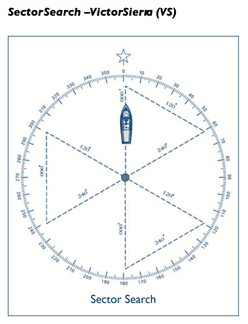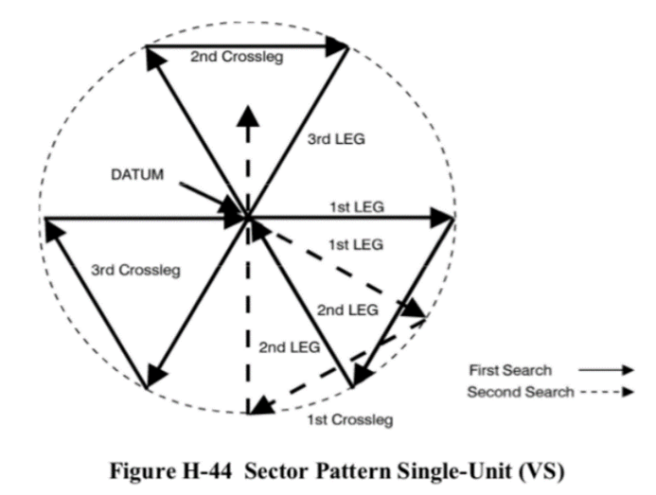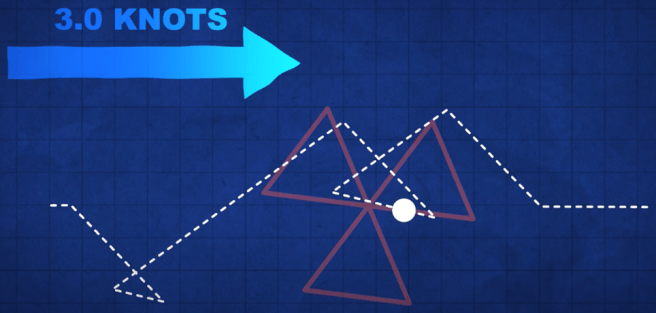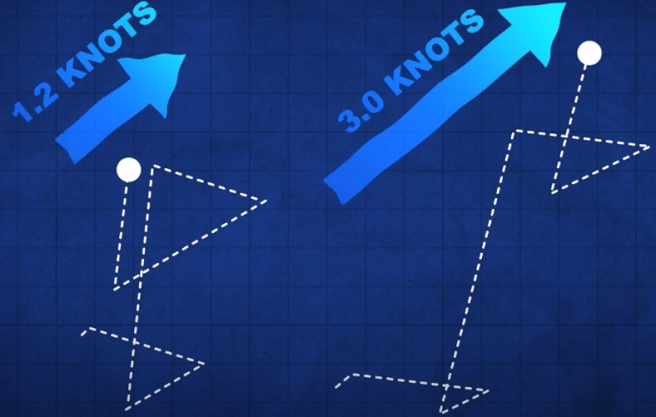I watched an informational video about search patterns used by the Coast Guard and gained some thoughts I decided to share. The video was just under 30 minutes long and you can find it right here if you’re interested.
As you read this article, see what you notice from outside our field that could serve as hints to help improve our clinical work as addiction professionals.
What are we looking for and where is it heading?
The video I watched showed how Coast Guard search and rescue teams vary their search patterns and their use of search assets (ships, planes) according to:
- the type of object they are looking for;
- the size of object;
- the height and amount of visible surface area of the object above the surface of the sea;
- and “drift”.
As an example, they noted a person wearing a life jacket will float differently from a disabled flat-bottom boat.
Interestingly, they said that drift of the object will vary according to the total of the ocean current at the surface, the deeper current, and the wind. And they clarified that the different currents and wind might each be flowing in the same direction, or different directions.
To me all of that was fascinating and I started to consider possible areas of application for our work. Among other things, I asked myself things like: “As addiction professionals, what is it we are looking for and why? And where is the patient heading?”
Is our work complicated enough? Are we letting science help us?
The search crew stated that all the relevant data about the different currents and the wind are put into a computer. And the software then generates a tailored search pattern for that specific scenario. And the pattern is given to the air assets, ships, and personnel conducting the search.
- They stressed that different things float differently, and the atmospheric and ocean currents and conditions also differ.
- And they stressed the fact that all the relevant Coast Guard staff experience standardized training, so they will all understand the same things and follow the same procedures.
Again, I started to think about our work. Among other things, I wondered if we have made our work complicated enough, and if we as a field are really letting science help us like we could.
Best-practice, structured methodology? That also champions the patient?
In the video, the “Victor Sierra” search pattern was featured.
The Victor Sierra search strategy is used to look for a small object in a relatively small location where the probability of the object being within that location is relatively high. The pattern is built from 3 isosceles triangles. It was initially odd to me, but rather interesting.

https://ccga-pacific.org/files/library/Chapter_9_Search.pdf. Accessed from the world wide web on 01/22/2022
During the use of the Victor Sierra search pattern, one of the crew is assigned to look out the left side of the vessel, one the right side, and one out the front – visually covering the entire search area in a thorough and reliable way.
But before the search begins the direction that the object is moving in is determined. And the direction is determined from the combination of the wind and both shallow and deeper currents.
That combination is used to understand the movement of the object being searched for, and also for a buoy they call the “datum”. The datum is placed in the water and left free to float and move on its own according to the wind and currents – just like the object being searched for.
The word “datum” is fascinating to me because it indicates a single reference point. The presenter noted that in engineering “datum” is the reference point from which one measures other things.

http://wow.uscgaux.info/Uploads_wowII/070/SEARCH_and_RESCUE-A_Guide_for_Coxswains_May_2020.pdf Accessed from the world wide web on 01/22/2022
But in this case the datum is literally a moving thing, not a fixed or stationery thing. And its motion (direction and speed) are the sum of the wind, shallow current, and deep current.
They went on to say that the search vessel’s initial motion is always in literal line with the movement of the datum.

Accessed from the world wide web on 01/22/2022
Interestingly, once the datum is deployed in the water, the ship backs away from it – in order to not effect it or its movement. The angles of the search pattern are then followed at a fixed rate of speed, at a set distance for each, and completed in a certain order.
As I watched the video, I saw many metaphors related to our work. And I asked myself many questions. For example, “Do we have a nationally-normed, universally applicable, best-practice structured methodology to guide us? One that champions the patient as the center?”
How person-centered are we?
Interestingly, the order in which the segments of the search are completed is static, but that order does not complete one full triangle at a time.
How is the search pattern followed?
- The first leg of the search starts from the location of the datum and is in the direction of the wind/water as crew can best determine.
- Once that first leg of the search is completed, the next angle is calculated from the location of the end of the first leg.
- Following the completion of this second leg, the ship heads directly back to the datum, and this is not done on a preset or calculated heading. Rather, the crew visually locates the datum and drives straight to it.
- Once they physically reach the datum, the direction/degree/angle of the next leg of the search is then determined.
As the search proceeds in this way, the search pattern is kept integrous by repeatedly returning to the datum, rather than making successive calculations from calculated locations. And in this way each new search angle moves with the natural combined movement of the wind and water.
I personally found the level of structured methodology and intentional freedom in the planned work they describe greatly inspiring.
And I asked myself if it is realistic to anticipate in the future:
- a universally available set of best-practice structured methodologies;
- that champion the patient;
- created for us on a normed basis;
- and specifically tailored to the particulars of the current person and their situation.
I ask myself if we are willing to be guided in the most expert way possible?
Messy inconsistency or a combination of expertise and natural forces?
Given drift, the lines that are ultimately searched do not form triangles. This is because the search lines move in time, congruent with the buoy.

By contrast, if the buoy did not move, the course of the search craft would simply replicate the pre-set triangular pattern. But it never does. The actual final shape of the search pattern is non-intuitive and always reflects the actual current/wind.
The shape of the search pattern will differ with the rate of the drift. The search moves with the current.

- For me, the wind is the manifest content of the life of the patient.
- And the water current is the latent content of the life of the patient on both shallower (more accessible) and deeper (less accessible) levels.
- And for me, the buoy reminds me of the person we are searching to help – who is always moving and provides us our center of reference.
This portion of the video made me wonder if we should consider a return to that center each time we complete our immediate purpose, and before we chart our next clinical move.
And it made me think about how our work appears from the outside. For example, does such work reflect messy inconsistency when viewed from the outside? Or does our work trace the combination of expertise and natural forces when viewed from the inside?
Appreciating drift, rescue, and what comes after rescue
The Coast Guard staff informed the film maker that wind and water are often aligned differently or may even be in opposition. They noted that these may all differ from each other due to the differing forces that produce each of them separately. To me, that fact alone is interesting and informs our work.
And they added that the most important task is the first task – determining the “set” and “drift” of the buoy. They stated that “set” refers to the direction of the buoy and “drift” refers to the speed of the buoy.
Once the starting center point of the pattern is established, the direction for the first leg of the 3 triangles is determined by going with the elements, not against them. They also stated that once the speed of the craft is set, it is not changed. Rather they, “Let the current take us.”
- To me this shows us the value of person-centered methods.
And to me this illumines areas of possible struggle for professional workers in our field. For example, do we choose:
- the datum (strictly person-centered reality) as our only reference point;
- the lighthouse that we might need to move toward once the rescue has been accomplished as our reference point; or
- the north star of long-term improvement as our reference point?
Which reference location do we use in the current moment? Or should we combine reference locations? Or at times oscillate between them?
For our work, would we only and always choose the location of the datum as the imagined destination of “full recovery 5 years after the last clinical touch”? Or should we always and only place it and leave it at the epicenter of the person served?
Or could the location of the datum be different, at different times, for different or changing purposes?
- If the epicenter of our work is the person served, then the patient is the reference point.
- If the epicenter is an imagined and much-fuller quality of life, is our effort meaningfully sufficient using that and only that long distance improvement as our only reference?
- But even then, who should define the hoped-for final location, and when, and on what terms?
And speaking of location, what about wind, shallow currents, and deep currents – at the location of the patient’s home or newer waters once they arrive safe? Are we also building safe-harbor locations in our society and larger communities? Do we appreciate all three of: drift, rescue, and what comes after rescue?
Science and compassion?
To conclude I’ll say that I imagine clinical work that includes:
- inputs from the patient, family members, clinical workers, and research scientists;
- reference points including the current condition of the person we serve contextualized by environmental conditions as they are;
- incremental markers to a safe harbor; and
- much farther true-north type wellness goals.
And I imagine our work both moving toward, and rotating on or pivoting against, pairs or groups of these markers (rather than only using one passive reference point) in best-practice algorithms, as we proceed.
Bob Lynn has summarized his aim for our work as “science and compassion”.
Hopefully this article has presented a framework and some considerations inspiring addiction professionals toward that aim.
Suggested Reading
Behavioral Health Recovery Management: A Statement of Principles.
Hofmann, S. G. & Hayes, S. C. (2018). The Future of Intervention Science: Process-Based Therapy. Clinical Psychological Science. 7(1): 37-50. doi.org/10.1177/2167702618772296
Proctor, S.L, Llorca, G.M., Perez, P.K. & Hoffmann, N.G. (2016). Associations Between Craving, Trauma, and the DARNU Scale: Dissatisfied, anxious, restless, nervous, and uncomfortable. Journal of Substance Use. DOI:10.1080/14659891.2016.1246621